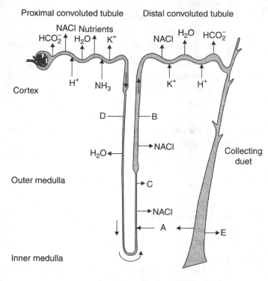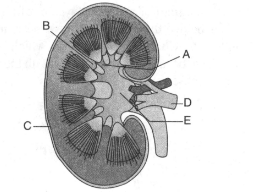Human Excretory System
Human Excretory System: Overview
This Topic covers sub-topics such as Kidneys, Nephron, Human Excretory System, Urethra, Urinary Bladder, Ureters, Bowman's Capsule, Renal Pelvis, Glomerulus, Minor Calyx, Major Calyx, Loop of Henle, Vasa recta, Proximal Convoluted Tubule and, Renal Cortex
Important Questions on Human Excretory System
Glomeruli are confined to
Which one of the following correctly explains the function of a specific part of a human nephron?
Formation of concentrated (hyperosmotic) urine in vertebrates generally depends on
Given below are statements: one is labelled as Assertion A and the other is labelled as Reason R.
Assertion A: Nephrons are of two types: Cortical and Juxta medullary, based on their relative position in cortex and medulla.
Reason R: Juxta medullary nephrons have short loop of Henle whereas, cortical nephrons have longer loop of Henle.
In the light of the above statements, choose the correct answer from the options given below:
Consider the following:
A. Bowman's capsule
B. Loop of Henle
C. PCT
D. DCT
Which of the above is/are present in cortex region of kidney?
Where the juxtaglomerular cells are present?
Describe the structure of mapighian body.
Filtration of blood during urine formation takes place in
Read the following statements and select the correct statements in the given options:
I) Blood flows into the glomerulus through the efferent arteriole.
II) Glomerulus along with Bowman's capsule forms renal corpuscle.
III) Vasa recta is a fine branch of afferent arteriole.
IV) Juxta medullary nephrons have long loop of Henle.
What is hilus in a kidney?
Why the left kidney is slightly higher than the right kidney?
Which one of the following statements is incorrect?
The functioning of kidney is regulated by
Human kidney produces how much concentrated urine than the initial filtrate formed?
Which of the following is mainly reabsorbed from Henle's loops?
The various parts in the following diagram absorbs different nutrients.

Identify and in the given diagram.
Select the total number of correct matching.
Observe the following figure.

Identify A to D in the given structure.
Which one of the following is not a part of uriniferous tubule?
In a glomerulus,
